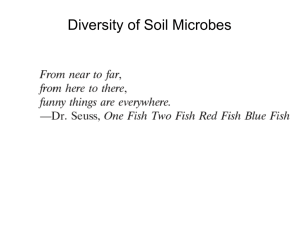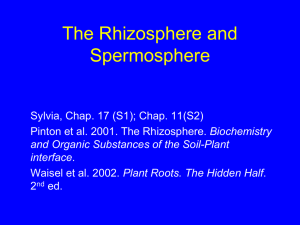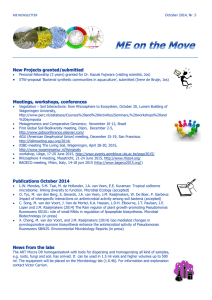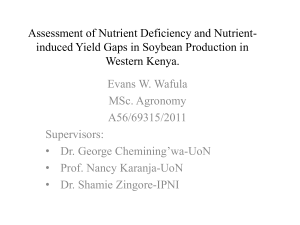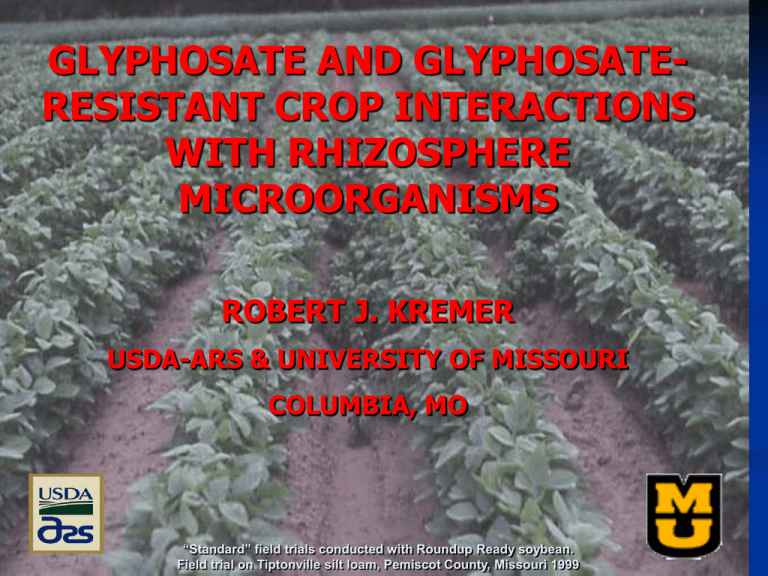
GLYPHOSATE AND GLYPHOSATERESISTANT CROP INTERACTIONS
WITH RHIZOSPHERE
MICROORGANISMS
ROBERT J. KREMER
USDA-ARS & UNIVERSITY OF MISSOURI
COLUMBIA, MO
“Standard” field trials conducted with Roundup Ready soybean.
Field trial on Tiptonville silt loam, Pemiscot County, Missouri 1999
Introductory Comments Regarding the Symposium
Development of genetically modified (GM) crops seeks to
improve agricultural productivity. However, assessments of
specific yet important processes and microorganisms have
been largely neglected although these aspects contribute to
a strong feedback that influence crop productivity and the
ecological balance in our soil resource.
We must continue to emphasize our position in addressing
the key issues concerning the impact of GM crops on soil
systems and the sustainability of agriculture.
Glyphosate and Glyphosate-Resistant Crops
(‘Roundup-Ready’ [RR] Production System)
• Advancement in effective weed management (despite
the insidious development of glyphosate-resistant
weed biotypes)
• Among the consequences of the RR system are
alterations in microbial ecology and biology of the
rhizosphere environment affecting:
• Nutrient cycling (plant availability)
• Potential phytopathogen and antagonist balance
• Composition and activities of beneficial
microorganisms (i.e., mycorrhizae, plant-growth
promoting rhizobacteria)
TRANSGENIC CROPS AND SOIL BIOLOGY RESEARCH
– USDA-ARS & UNIVERSITY OF MISSOURI
OBJECTIVES:
1. UNDERSTAND IMPACTS OF TRANSGENIC CROP
PRODUCTION ON
a. SOIL BIOLOGICAL INTERACTIONS ;
b. DISCOVER MECHANISMS RESPONSIBLE FOR
OBSERVED EFFECTS
2. DETERMINE APPROACHES TO OVERCOME PRODUCTIONLIMITING FACTORS EVOLVING FROM DETRIMENTAL
TRANSGENIC CROP-SOIL BIOLOGICAL INTERACTIONS
BACKGROUND –
Evaluation of Genetically-Modified Crop X Soil/Rhizosphere
Interactions since 1997
Original objectives –
Determine root-associated fungal pathogens on RR
soybean (i.e., Fusarium solani pv. glycines) (what level of
Sudden Death Syndrome develops in RR soybean?) What
is impact of glyphosate use?
Determine root populations of soybean cyst nematode
(SCN) (Heterodera glycines) on RR soybean
Evaluate Fusarium collected from roots for potential
biological control of SCN (RR soybean promote
populations of biocontrol fungi?)
Early Results –
• No consistent trends in population of SDS fungal
pathogen
• No consistent trends in population development of SCN
• Few Fusarium cultures showed biological control activity
against SCN
• Consistent increases in Fusarium spp. colonizing RR
soybean roots with glyphosate applications at label rates
Increased Fusarium colonization attributed to possible lower or altered
synthesis of phytoalexins, based on previous work on glyphosate
‘secondary mode of action’ (Johal & Rahe. Phytopathology 74:950, 1984; Levesque & Rahe,
Annu. Rev. Phytopathol. 30:579, 1992)
and altered root exudation patterns due to genetic modification or
glyphosate interactions in planta (Kremer et al. Int. J. Environ. Anal. Chem. 85:1165, 2005)
These findings helped partially explain reported production problems with RR
soybean experienced by many farmers in midwestern U.S.
Typical soybean root
colonization assay results
observed consistently,
1997-2007
Fusarium colonization – 2007 study
+ Glyphosate
Check
Fusarium colonies per 100 cm root
Typical trend in Fusarium colonization of RR roots
Summary - consistent trends over years
Fusarium Root Colonization on RR Soybean 1997-2007
Fusarium colonies per
100 cm root
120
100
80
60
40
20
0
Roundup
Check
Tank Mix
Herbicide
1997
1998
1999
2001
2002
2003
2005
2006
2007
Identification of Root Fusarium Isolates
1. Subculture, characterize based on cultural and microscopic
morphology; key based on Nelson et al. (1983)
2. Verified via nuclear DNA translation elongation factor sequence
primer and Penn State database (Skovgaard et al. (2001)*
Identifications Over All Treatments:
Fusarium oxysporum complex – 72%
Fusarium solani complex –
F. solani fsp glycines
conidia
18%
Fusarium equiseti –
9%
*Analyses conducted at ARS Mycology Lab,
Peoria, IL by Kerry O’Donnell, 2004
Photo: D. Sasseville
Fusarium shown to be good indicator of potential impacts of
GM crop on rhizosphere ecosystem – most can be
opportunistic pathogens if not directly infectious, and
respond to various factors and alterations in the rhizosphere
However, the rhizosphere is a COMPLEX system – a more
comprehensive examination of Structure and Function of
microbial communities needed to provide a complete
assessment of potential effects induced by GM cropping –
This will yield better understanding of mechanisms
contributing to impacts of GM on soil ecology/biology AND
crop productivity.
Complexity of the rhizosphere / soil ecosystem presents
formidable challenge in devising an appropriate Framework
that effectively evaluates effects of GM crops
**Use of indicator groups and specific microbial activities
that are sensitive to ecosystem changes and that are
relevant to the particular GM system in place is proposed.
A ‘polyphasic’ microbial analyses to target the broad impact
on the total microbial community, thus a multiple analyses
provides a more reliable view of GM effects than any single
technique alone.
Based on guidelines for assessing responses of soil
microorganisms to GM plants by –
Bruinsma et al. Biol. Fert. Soils 37:329, 2003;
Kowalchuk et al. Trends Ecol. Evolut. 18:403, 2003.
Proposed polyphasic microbial community analyses
Difficult to
demonstrate
impact
Likely most
sensitive to
ecosystem
alteration by
GM crops
Source: Kowalchuk et al. 2003. Trends Ecol. Evolut. 18:403-410.
In studies of effects of glyphosate on soil and rhizosphere microbial
communities where only ‘general’ properties are measured, no effect
due to glyphosate and/or RR soybean is concluded See Liphadzi et al. Weed Sci. 53:536, 2005; Weaver et al. Pest Manage. Sci. 63:388,
2007; Means et al. J. Environ. Sci. Health B 42:125, 2007. (Note: most studies deal
with soil, not rhizosphere communities)
An example:
SOIL DEHYDROGEANSE ACTIVITY:
2003
2002
g TPF · g dry soil -1
No Herbicide
Tank-Mix
Glyphosate
3
3
2
2
1
1
0
Vertical bars indicate LSD (P<0.05).
0
0
5
10
15
20
25
0
5
10
Days after Herbicide Application
Source: Means et al., 2007
Glyphosate
15
20
25
OUR ASSESSMENT OF POTENTIAL TRANSGENIC CROP EFFECTS IS AN
“EVOLVING FRAMEWORK” BASED ON OBSERVATIONS OVER 10 YR
THUS, THE CURRENT APPROACH:
EXAMINE SPECIFIC RHIZOSPHERE MICROBIAL COMMUNITIES AND THE
ASSOCIATED ACTIVITIES => DETERMINE ANY FUNCTIONAL
CONSEQUENCES OF RR CROPPING SYSTEM
OUR SPECIFIC ANALYSES INCLUDE:
A. RHIZOSPHERE FUNGAL COMMUNITIES – FUSARIUM
B. Mn-TRANSFORMING MICROORGANISMS (OXIDIZERS & REDUCERS)
C. SYMBIOTIC NITROGEN FIXING RHIZOBIA
D. PSEUDOMONAD COMMUNITIES
E. ARBUSCULAR MYCORRHIZAL FUNGI (AMF)
THE ABOVE COMPONENTS ARE INTERACTIVE AND MAY EXPLAIN ANY
LINKAGES OF SHIFTS IN MICROBIAL COMMUNITY STRUCTURE WITH
FUNCTIONAL ALTERATIONS.
RECALL Glyphosate is systemic – the
amount not adsorbed to the EPSPS
enzyme is transported throughout
the plant.
In RR soybean, glyphosate has been
found localized in meristematic
tissues of growing points, leaves
and roots; pod and seed; nodules.
Also glyphosate is actively released
through roots into rhizosphere soil
(root zone) likely with high amounts
of carbohydrates & N-compounds in
RR soybean
(Kremer et al. Int. J. Environ. Anal. Chem. 85:1165,
2005)
Interacting factors that determine rhizosphere community - overlaid with
Management, may have additive effect on microorganisms with root
exudation patterns of plants (see de Boer et al. New Phytol. 170:3, 2006)
a. Herbicide (glyphosate)
b. GM crop varieties
Representation of components and their interactions involved in plant growth
Kremer, 2006 (modified from Agrios, 1988: Huber & McCay-Buis, 1993).
Methodology –
*Protocols to define the sample under test must be
followed: what constitutes ‘rhizosphere soil’ vs
‘bulk soil’ or rhizosphere vs rhizoplane?
Considerably more activity and alterations occur in
the rhizosphere micro-environment than in ‘bulk soil’
Remove bulk soil from
roots with vigorous
shaking; meticulously
collect tightly adhering
rhizosphere soil with
intense brushing of root
surface
Nodule mass (mg/plant)
Variety and Herbicide Effects on Soybean Nodule Mass
2005 Field Study, R1 Growth Stage – Mid-Missouri USA
Roundup Ready*
4000
Williams 82
3500
3000
LSD(0.05)
2500
2000
1500
1000
500
0
RU
TM
HW
TM
HW
Herbicide Treatment
*DeKalb DKB38-52
RU=Roundup; TM=Tankmix conventional herbicide;
HW=Handweeded check
Recent report of alteration of rhizobial cell structure by glyphosate in
de Maria et al. Appl. Environ. Microbiol. 73:5075, 2007
Nodulation generally lower on
RR regardless of treatment
Does glyphosate interfere with
flavonoid signals required for
rhizobia attachment to root?
Impact on PGR substances?
Glyphosate Effects on Soybean Nodule and Root Mass
2007 Field Study, R2 Growth Stage – Mid-Missouri USA
(similar to 2006 results)
Root Mass
8
840
Root Fresh Wt (g/plant)
Nodule mass (mg fresh wt/plant)
Nodule Mass
820
800
780
760
740
720
700
7
6
5
4
3
2
1
0
Check
RR variety:
Pioneer 93M92
RU
Check
RU
Root mass can be decreased by
Fusarium infection (Agrios, 1988)
Key Indicator Mn transformations
primarily microbiallymediated, thus have
major impact on plant
nutrient availability
Potential Mn-oxidizing
(black) & Mn-reducing
bacteria (white, clear) and
fungi on roots, in
rhizosphere soils
Rhizosphere bacteria X 10^5 / g
soil
Ratio of potential Mn-reducing and Mn-oxidizing bacteria in
rhizosphere of soybean-herbicide treatments - Stage V4, 2006
120
0.33
Mn Red
Mn Ox
100
Higher ratio of Mnreducers:Mn
oxidizers implies
higher plant
availability of Mn
(Rengel. Plant Soil
196:255, 1997)
80
0.33
60
0.66
0.17
0.51
40
20
0
W82
W82+TM
RR
RR+TM
RR+RU
Soybean var. X Herbicide
W82= ‘Williams 82’; RR 2006=DK-838-52; TM= Conventional herbicide tankmix; RU= Roundup
Ratio of potential Mn-reducing and Mn-oxidizing bacteria in
rhizosphere of soybean-herbicide treatments - Stage R2, 2006
250
Rhizosphere bacteria (cfu x 10^5 / g
soil)
0.87
Mn Red
Mn Ox
0.61
200
0.59
150
0.09
0.67
100
50
0
W82
W82+TM
RR
RR+TM
Soybean var. x Herbicide
RR+RU
W82= ‘Williams 82’; RR 2006=DK-838-52; TM= Conventional herbicide tankmix; RU= Roundup
Rhizosphere bacteria (cfu x 10^5 /g soil)
Ratio of potential Mn-reducing and Mn-oxidizing bacteria in
rhizosphere of soybean-herbicide treatments - Stage R1, 2007
300
Mn Red
Mn Ox
0.85
250
200
150
0.29
100
50
0
RR
RR+RU
Herbicide Treatment
RR variety:
Pioneer 93M92
Secondary Observation: majority of bacterial colonies with Mnoxidizing activity also produce copious amount of
exopolysaccharides (EPS); very frequently observed with
RR+RU; most colonies classified as Agrobacterium spp.;
Suggests formation of ‘biofilms’ on roots -- What is relationship
between Agrobacterium, biofilms, and glyphosate?
Agrobacterium sp. colony with
presumed Mn-oxidizing ability
showing excess EPS
Biofilm - microbes attached to surface (rhizoplane),
aggregated in polymeric matrix (EPS); concentrates
extracellular enzymes; mediates many functions
(Jass et al., 2002),
Including Mn oxidation - in which Mn oxides are
precipitated and retained
(Toner et al. Appl. Environ. Microbiol. 71:1300, 2005)
Is biogenic Mn oxidation within
biofilms enhanced on RR soybean
with or without glyphosate
amendment??
Demonstration of EPS production by
Agrobacterium cultures
Rhizosphere bacteria on plant root surfaces as BIOFILMS
Role of rhizosphere bacteria on GM crop growth?
Bacterial aggregates in layer of EPS forming biofilm
KEY GROUP: Rhizosphere Pseudomonads
Important multi-functional bacterial group in rhizosphere
community (Schroth et al. Prokaryotes 6:714, 2006)
Many fluorescent pseudomonads associated with antagonism of
fungal pathogens (Schroth & Hancock. Science 216:1376, 1982)
and Mn transformations (Rengel, 1997)
RR+TM
W82+HW
Fluorescent pseudomonad
colonies visualized under
UV light.
W82+TM
RR+RU
Relative proportion or composition of Pseudomonas
spp. altered in RR or RR+RU treatments. Does
glyphosate alter this component in rhizosphere; does
genetically-altered RR plant affect composition?
Pseudomonas (cfu x 10^5 / g soil)
Rhizosphere bacteria (cfu x 10^5 /g soil)
Populations of fluorescent pseudomonads in rhizospheres of
soybean-herbicide treatments - 2006
90
Pseudomonad populations greater in conventional
system than RR across growth stages
80
V4
R2
70
60
50
40
30
20
10
0
W82
W82+TM
RR
RR+TM
RR+RU
Soybean var x Herbicide
W82= ‘Williams 82’; RR 2006=DK-838-52; TM= Conventional herbicide tankmix; RU= Roundup
Populations of fluorescent pseudomonads in rhizospheres of
Roundup Ready soybean (R1) - 2007
Pseudomonads (cfu x 10^5 / g soil)
120
Glyphosate seemed to be associated with
greater suppression of fluorescent
pseudomonads in 2007 – variety effect?
100
80
60
40
20
0
RR
RR+RU
RR variety:
Pioneer 93M92
Relationship between colonization of soybean roots by
fluorescent Pseudomonas spp. and by Fusarium spp.
Rhizosphere Pseudomonas
90
80
70
y = -0.8303x + 94.951
R2 = 0.761
60
50
40
Glyphosate (RU)
treatments on RR
30
20
10
0
0
20
40
60
80
100
Fusarium Root Colonization
120
In vitro assays for interactions of
rhizosphere bacteria with fungi:
I. Antagonism of Fusarium by
bacteria
Fungal growth
suppression or conidial
germination stimulation by
rhizobacterial cultures
II. Protease assay of selected rhizosphere bacteria on milk
protein agar [positive test indicated by clearing around
bacterial growth] => possible antagonism mechanism
Characteristics of Some Rhizosphere Bacteria Cultured from Soybean, 2006-2007
Bacterium
Source
Fluor
EPS
Mn
Fusarium
Suppression
Protease
Pseudomonas
W82+HW
+
-
Red
+
+
Pseudomonas
W82+HW
+
-
Red
+
-
Pseudomonas
RR+TM
+
+
Red
+
++
Pseudomonas
W82+TM
+
-
Red
++
++
Pseudomonas
RR+RU
+
++
Ox
-
-
Pseudomonas
RR+RU
-
-
Red
±
-
Pseudomonas
RR+HW
+
-
Red
+
-
Chryseobacterium
RR+HW
-
-
Red
++
±
Agrobacterium
RR+RU
-
++
Ox
-
-
Agrobacterium
RR+RU
-
+
Ox
-
-
Agrobacterium
RR+RU
-
+
Ox
-
-
Agrobacterium
RR+RU
-
+
Ox
-
-
Agrobacterium
RR+RU
-
++
Red
-
±
Agrobacterium
W82+HW
-
+
Red
+
-
Fluor=Fluorescence;
EPS=Exopolysaccharide
Mn reduction greater factor in fungal suppression than enzymatic process or
antibiosis in conventional system? Suggested by Huber & McCay-Buis, 1993
Linking Function to Structure – Molecular Fingerprint of Microbial Communities
PCR-DGGE of bacterial DNA extracted from soybean rhizosphere and bulk soils
Pseudomonas
marker
Agrobacterium
marker
Soil 2006
W82
R3
2006
RR
2006
W82
V4
2006
RR
2007
RR
2006
Bacterial diversity (no. of DNA bands, Shannon index) in soils and
soybean rhizospheres affected by variety, herbicide, growth stage.
Variety X
Herbicide
Soybean
Growth Stage
Season
W82
V4
2006
20
3.50
W82 + Herb
V4
2006
18
3.40
W82
R3
2006
22
3.89
W82 + Herb
R3
2006
22
3.25
RR
V4
2006
21
2.80
RR + Herb
V4
2006
27
3.00
RR + RU
V4
2006
21
2.20
RR
R3
2006
20
2.85
RR + Herb
R3
2006
26
3.20
RR + RU
R3
2006
18
2.10
2006
16
0.45
‘Bulk’ Soil
No. of DNA
Bands
Diversity
Index
RR
V8
2007
24
3.20
RR + RU
V8
2007
18
2.00
2007
15
0.52
‘Bulk’ Soil
Roundup Application
Complexity of the soil &
rhizosphere ecosystem
confounded by RR technology
(systemic movement of
glyphosate to roots)
Soybean root
Beneficial (i.e., biocontrol) or
Pathogenic (i.e., SDS agent)??
High carbohydrate contents
Glyphosate
Bradyrhizobia,
nodulation
interactions?
Fusarium spp.
Rhizosphere
bacteria
interactions
with fungi
Mycotoxins
Microbial
Biofilms
Mn, Fe oxidation /
reduction
Factors affecting interaction:
Enzymes, Toxins
Soil moisture/temperature
PGPRs (auxins)
Clay mineralogy/soil type
antagonisms
Mycorrhizal
Interactions
Soil organic matter content
RR soybean variety
Soil nutrient status -i.e., Mn
Management - crop rotation,
tillage
Observations on Assessment of Glyphosate and
Glyphosate-Resistant Crops for Soil-Microbial-Plant
Interactions (“More questions, some answers”)
Examine Key Indicators *Specific microbial groups and functions (nutrient
transformations, specific fungi/bacteria, mycorrhizae);
specific plant parameters (root growth, nodulation) may
be most sensitive to potential impacts of GM plants.
Decreased diversity in RR soybean (molecular
fingerprint) is of concern because high diversity is
essential to maintain stable ecosystem productivity.
(Dunfield & Germida. J. Environ. Qual. 33:806, 2004)
Use of ‘conventional cropping system’ illustrated a
more balanced rhizosphere community relative RR
system demonstrated by proportion of Mn
transforming bacteria; pseudomonad population size
relative to Fusarium colonization; and apparent
nitrogen fixation represented by root nodulation
Polyphasic microbial analyses (integrated approach
combining specific assays with structural
characterization) shows impacts not limited to
Fusarium; several key microbial groups/functions
involved in rhizosphere interactions are affected
*General analyses will not likely yield measurable or
differential responses (soil respiration; microbial
biomass C/N; general soil enzyme activities)
See Liphadzi et al., 2005 ; Means et al., 2007; Weaver et al., 2007)
IMPACT OF RESEARCH – “in a word” – MANAGEMENT
An understanding of factors in soils and
rhizospheres (root exudation, glyphosate release,
microbial characteristics) that interact with rootassociated microorganisms is essential for
developing ways to manipulate the rhizosphere
environment to reduce/eliminate adverse effects
(i.e., root infection, nutrient availability) -especially critical in context of transgenic crops as
part of a management system
+ Glyphosate
Check
Glyphosate +Salicylate
ACKNOWLEDGMENTS
USDA Special Grant – SCN
Technicians: Jenan Nichols; Jim Ortbals
Field crew: Tim Reinbott; Steve Troesser
Graduate students: Nathan Means; Su-jung Kim
Undergrad student assistants: Heidi, Atim, Michael,
Sarah, Ashley, Luke
Thanks to Yamada for
organizing and the
invitation to participate in
this important symposium
CFU per 100cm root
MAIZE ROOT FUSARIUM
100
Glyphosate
75
tank-mix
50
25
0
0
10
20
Days + Herbicide Application

